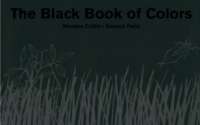
The Black Book of Colors
Written by Menena Cottin
Illustrated by Rosana Farla
Translated by Elisa Amado
Groundwood, 2009
ISBN: 978-0888998736
This captivating, hands-on book conveys a blind person’s perception of colors using matte black pages with embossed glossy representations of objects and simple descriptive statements. Each color is explored non-visually, evoked through taste, smell, feel or sound, never appearance–“Thomas says that yellow tastes like mustard, but is as soft as a baby chick’s feathers.” Red is the sting of a skinned knee and the tartness of an unripe strawberry, while brown is the crunch of fall leaves and the smell of chocolate. The observations that Thomas makes about each color reveal an assertive and engaging character, moving the book beyond color concepts.
Each all-black double-paged spread is devoted to one color, with the simple sensuous text rendered in a clear white typeface and in raised Braille letters on the left while the right illustrates the objects with raised lines that encourage tactile explorations by readers. Readers are invited to imagine experiencing the world by living fully with their senses beyond sight. This visually stunning picture book provides a unique and innovative reading experience as well as serving as an educational resource for discussing difference, perspective, and ways of experiencing the world. A full Braille alphabet is included in the book. A special edition of the book with Braille-punched parchment is available for the blind.
The book was originally published in Mexico as El libro de los colores, by an author and illustrator from Venezuela. The book has received excellent reviews and multiple awards, including the New Horizons Prize at the 2007 Bologna Children’s Book Fair, although it has also been critiqued as condescending to the blind for whom color is not significant. Menena Cottin studied design and illustration at the Pratt Institute in New York and lives in Venezuela. Her other titles include Equilibrio (2007) and La doble historia de un vaso de leche (2007). Rosana Faria lives in Caracas, Venezuela and has illustrated many picture books, including Nina Bonita: A Story (2001), written by Ana Maria Machado. Elisa Amado is a Guatemalan writer and translator who lives in Toronto, Canada. She frequently translates books from Spanish to English for Groundwood and has written several books, including Tricycle (2007) and Cousins (2004).
This book can be paired with other books on experiencing the world without eyesight, such as Do You Remember the Color Blue? And Other Questions Kids Ask about Blindness (Sally H. Alexander, 2000), See the Ocean (Estelle Condra, 2006), Piano Starts Here: The Young Art Tatum (Robert A. Parker, 2008), and The Seeing Stick (Jane Yolen, 2009). The Sound of Colors by Jimmy Liao (2006), translated from Chinese, focuses on a young blind girl who travels the subway as her mind takes her on imaginative journeys and so provides an interesting perspective and character. Another possibility is books about color, such as the classic book of color poetry by Mary O’Neill, Hailstones and Halibut Bones (1990), or Red Sings from Treetops (Joyce Sidman, 2009), which contains poetry describing the seasons through color.
Kathy G. Short, University of Arizona, Tucson, AZ
WOW Review, Volume III, Issue 1 by Worlds of Words is licensed under a Creative Commons Attribution-NonCommercial-ShareAlike 4.0 International License. Based on work at https://wowlit.org/on-line-publications/review/iii-1/

This book sounds like I would enjoy it. When I first started reading about it, I thought it was going to remind me of KIRA-KIRA. That book also mixes her native language into the text, but it flows enough that you can too usually figure out what it means through context. For this book, I would like the “aha” chapter titles and the complexity of the circle element. It’s also a good book to add to any collection as it’s always nice to be culturally diverse with your collection.